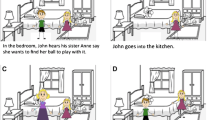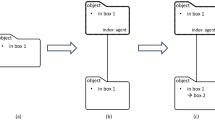Abstract
The contributions of counterfactual conditional reasoning (CCR), belief understanding, and inferential reasoning to the performance of children with autism (CWA) on standard false belief tasks were investigated. To assess the roles of these three factors, we compared the performance of CWA on physical-state CCR tasks (which do not require either an understanding of belief or inferential reasoning); on Wellman and Bartsch's (1988) nonstandard tests of false belief (which require an understanding of belief, but not CCR or inferential reasoning), and on standard tests of false belief tasks. The CWA were impaired relative to controls on the physical-state CCR and standard false-belief tasks, but not on the nonstandard false-belief tasks, and the CWA's performance on the physical-state CCR and standard false-belief tasks correlated highly, even when the effects of verbal ability were partialled out. Finally, the CWA's performance on standard false-belief tasks was more impaired than their performance on the physical-state CCR tasks. We concluded that impaired performance on standard false-belief tasks in autism is associated with defective competence in CCR (or some of its component skills), plus defective competence in inferential reasoning and possibly generativity, but that impaired performance is not caused by an inadequate understanding of belief. The results are discussed in relation to other hypotheses concerning the cause or causes of impaired performance on standard false-belief tasks in children with autism.
Similar content being viewed by others

Reference
American Psychiatric Association (1994). Diagnostic and Statistical Manual of Mental Disorders. (4th ed.). Washington, DC: Author.
Baron-Cohen, S. (1991). Do people with autism understand what causes emotion? Child Development, 62, 385-395.
Baron-Cohen, S. (1995). Mindblindness: An essay in autism. Cambridge, MA: MIT Press.
Baron-Cohen, S. (2000). Theory of mind and autism: A fifteen year review. In S. Baron-Cohen, H. Tager-Flusberg, & D. J. Cohen (Eds.). (2000). Understanding other minds: Perspectives from developmental cognitive neuroscience. Oxford: Oxford University Press.
Baron-Cohen, S., Leslie, A. M., & Frith, U. (1985). Does the autistic child have a “theory of mind”? Cognition, 21, 37-46.
Craig, J., & Baron-Cohen, S. (1999). Creativity and imagination in autism and Asperger syndrome. Journal of Autism and Developmental Disorders, 29, 319-326.
de Villiers, J., & de Villiers, P. (1999). Linguistic determinism and false belief. In P. Mitchell & K. Riggs (Eds.), Children's reasoning and the mind. Hove: Psychology Press.
Dunn, L. M., Dunn, L. M., & Whetton, C. (1982). British Picture Vocabulary Scale. Windsor, UK: Nelson.
Farrant, A., Boucher, J., & Blades, M. (1999). Metamemory in children with autism. Child Development, 70, 107-131.
Frith, U. (1989). Autism: Explaining the enigma. Oxford: Blackwell.
Frye, D., Zelazo, P. D., & Palfai, T. (1995). Theory of mind and rule based reasoning. Cognitive Development, 10, 483-527.
Frye, D., Zelazo, P. D., & Burack, J. A. (1998). Cognitive complexity and control. I. Theory of mind in typical and atypical development. Current Directions in Psychological Science, 7, 116-121.
Happe, F. G. E. (1997). Central coherence and theory of mind in autism: Reading homographs in context. British Journal of Developmental Psychology, 15, 1-13.
Harris, P. L. (1995). Imagining and pretending. In M. Davies & T. Stone (Eds.), Mental simulation: Evaluations and applications. Oxford: Blackwell.
Harris, P. L., & Leevers, H. (2000). Reasoning from false premises. In P. Mitchell & K. J. Riggs (Eds.), Children's reasoning and the mind. Hove: Psychology Press.
Harris, P. L., & Kavanaugh, R. D. (1993). Young children's understanding of pretence. Society for Research in Child Development Monographs (Serial No. 237).
Jarrold, C., Boucher, J., & Smith, P. K. (1994). Executive function deficits and the pretend play of children with autism. Journal of Child Psychology and Psychiatry, 35, 1473-1482.
Leekam, S., & Perner, J. (1991). Does the autistic child have a metarepresentational deficit? Cognition, 40, 203-218.
Leslie, A. M., & Thaiss, L. (1992). Domain specificity in conceptual development: Neuropsychological evidence from autism. Cognition, 43, 225-251.
Leslie, A. M., & Roth, D. (1993). What autism teaches us about metarepresentation. In S. Baron-Cohen, H. Tager-Flusberg, & D. Cohen (Eds.), Understanding other minds: Perspectives from autism. Oxford: Oxford University Press.
Leslie, A. M., & German, T. P. (1995). Knowledge and ability in “theory of mind”: One-eyed overview of a debate. In M. Davies & T. Stone (Eds.), Mental simulation: Evaluations and applications. Oxford: Blackwell.
Minshew, N. J., & Goldstein, G. (1998). Autism as a disorder of complex information processing. Mental Retardation and Developmental Disabilities Research Reviews, 4, 129-136.
Ozonoff, S. (1997). Components of executive function in autism and other disorders. In J. Russell (Ed.), Autism as an executive disorder. Oxford: Oxford University Press.
Perner, J. (1989). Is “thinking” belief? Reply to Wellman & Bartsch. Cognition, 33, 315-319.
Perner, J. (1991). Understanding the representational mind. Cambridge, MA: MIT Press.
Perner, J., Leekam, S. R., Myers, D., Davis, S., & Odgers, N. (2000). Misrepresentation and referential confusion: Children's difficulty with false beliefs and outdated photographs. Unpublished paper, University of Sussex.
Peterson, D. M., & Bowler, D. M. (2000). Counterfactual reasoning and false belief understanding in children with autism. Autism, 4, 391-405.
Peterson, D. M., & Riggs, K. J. (1999). Adaptive modelling and false belief tasks. Mind and Language, 14, 80-112.
Phillips, W., Baron-Cohen, S., & Rutter, M. (1995). To what extent can children with autism understand desire? Development and Psychopathology, 7, 151-169.
Riggs, K. J., & Peterson, D. M. (2000). Counterfactual thinking in pre-school children: Mental state and causal inferences. In P. Mitchell & K. J. Riggs (Eds.), Children's reasoning and the mind. Hove: Psychology Press.
Riggs, K. J., Peterson, D. M., Robinson, E. J., & Mitchell, P. (1998). Are errors in false belief tasks symptomatic of a difficulty with counterfactuality. Cognitive Development, 13, 73-91.
Roth, D., & Leslie, A. M. (1998). Solving belief problem: Toward a task analysis. Cognition, 66, 1-31.
Russell, J., & Hill, E. L. (2001). Action-monitoring and intention reporting in children with autism. Journal of Child Psychology and Psychiatry, 42, 317-328.
Scott, F., Baron-Cohen, S., & Leslie, A. M. (1999). If pigs could fly: An investigation of counterfactual reasoning and pretence in autism. British Journal of Developmental Psychology, 17, 349-362.
Smith, M., Apperly, I., & White, V. (2003). False-belief reasoning and the acquisition of relative clause sentences. Child Development, 76, 1709-1719.
Sparrevohn, R., & Howie, P. M. (1995). Theory of mind in children with autistic disorder: Evidence of developmental progression and the role of verbal ability. Journal of Child Psychology and Psychiatry, 36(2), 249-263.
Tager-Flusberg, H. (2000). Language and understanding minds: Connections in autism. In S. Baron-Cohen, H. Tager-Flusberg, & D. Cohen (Eds.), Understanding other minds. (2nd ed.). Oxford: Oxford University Press.
Tan, J., & Harris, P. L. (1991). Autistic children's understanding of seeing and wanting. Development and Psychopathology, 3, 163-174.
Turner, M. A. (1999). Generating novel ideas: Fluency performance in high-functioning and learning disabled individuals with autism. Journal of Child Psychology and Psychiatry, 40, 189-202.
Wellman, H. M., & Bartsch, K. (1988). Young children's reasoning about beliefs. Cognition, 30, 239-277.
Zelazo, P. D., & Frye, D. (1998). Cognitive complexity and control. II. The development of executive function in childhood. Current Directions in Psychological Science, 7, 121-126.
Author information
Authors and Affiliations
Rights and permissions
About this article
Cite this article
Grant, C.M., Riggs, K.J. & Boucher, J. Counterfactual and Mental State Reasoning in Children with Autism. J Autism Dev Disord 34, 177–188 (2004). https://doi.org/10.1023/B:JADD.0000022608.57470.29
Issue Date:
DOI: https://doi.org/10.1023/B:JADD.0000022608.57470.29



